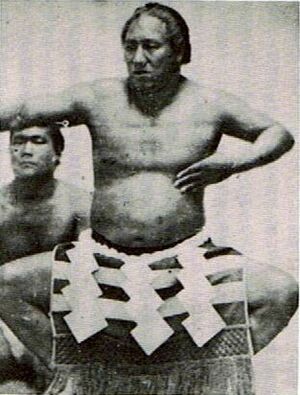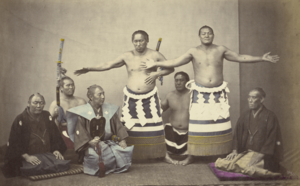Shiranui Kōemon facts for kids
Quick facts for kids Shiranui Kōemon |
|
|---|---|
| 不知火 光右衛門 | |
 |
|
| Personal information | |
| Born | Harano Minematsu March 3, 1825 Kikuchi, Higo, Japan |
| Died | February 24, 1879 (aged 53) |
| Height | 1.76 m (5 ft 9 in) |
| Weight | 124 kg (273 lb) |
| Career | |
| Stable | Minato → Sakaigawa |
| Record | 119-35-75 15draws-9holds(Makuuchi) |
| Debut | November, 1850 |
| Highest rank | Yokozuna (October 1863) |
| Retired | November, 1869 |
| Elder name | Shiranui |
| Championships | 3 (Makuuchi, unofficial) |
| * Up to date as of October 2007. | |
Shiranui Kōemon (Japanese: 不知火 光右衛門, March 3, 1825 – February 24, 1879) was a famous Japanese professional sumo wrestler. He came from Kikuchi, a place in what was then called Higo Province. Shiranui Kōemon became the 11th yokozuna, which is the highest rank in sumo.
Even though a special sumo ceremony style is named after him, it's not certain if he actually performed that exact style himself. He was a very popular wrestler during his time.
Contents
Becoming a Sumo Star
Shiranui Kōemon was born in March 1825. His birth name was Harano Minematsu, but he later changed it to Chikahisa. His grandfather was also a well-known sumo wrestler called Aramaki, who held the rank of ōzeki.
In 1846, when he was 21, he moved to Osaka to start his sumo career. He joined the Minato stable. The stablemaster, who was a former yokozuna named Shiranui Dakuemon, was also from Kumamoto. This connection helped him get started.
In 1847, he got his first shikona, or ring name, which was Shingari Minematsu. He made his professional debut in Osaka sumo. His stablemaster saw his great potential. So, in 1849, he moved to a different stable called Sakaigawa stable in Edo (now Tokyo). There, he used the ring name Shingari Minegorō.
A powerful family, the Hosokawa clan, then hired Shiranui to wrestle for them. He worked hard and reached the top makuuchi division in November 1856. He was then given his famous ring name, Shiranui Kōemon. This name combined his old master's name with the name of an ōzeki wrestler that the Hosokawa lord admired.
Reaching the Top Rank: Yokozuna
In March 1862, Shiranui Kōemon was promoted to ōzeki, a very high rank. However, he had to miss a tournament in 1863 due to a sad event known as the 'Koyanagi murder'.
Despite this, in October 1863, he was given the special yokozuna license by the Yoshida family. He became a yokozuna when he was 38 years old. His record as an ōzeki wasn't super strong, but he was very popular with the public. He had also served sumo for many years and was close to the Yoshida family, who decided who got the yokozuna license.
His ring-entering performances were amazing to watch. People loved them so much that a special woodblock print (called a nishiki-e) of him entering the ring was made and sold very well.
After becoming yokozuna, he continued to perform well. He retired from wrestling in November 1869. After retiring, he became a promoter in Osaka sumo until 1872. In the top makuuchi division, Shiranui won 119 matches and lost only 35. This means he won about 77% of his fights!
Later, he started his own sumo stable, using the name Shiranui Dakuemon. He also became the chairman of the Osaka Sumo Association. Shiranui Kōemon passed away in 1879. His grave is in Ōtsu, Kumamoto.
The Yokozuna Ceremony Style

One of the two main styles of the yokozuna dohyō-iri (the special ring-entering ceremony) is named after Shiranui. People said his ceremony was very beautiful. It was often a highlight for the crowds at tournaments, sometimes even more exciting than the actual sumo matches! He continued to perform this ceremony for three years after he retired from wrestling.
However, it's not actually proven that he performed the exact style that is now called the Shiranui style. Many sumo historians today believe he actually performed the Unryū style.
There's a picture of him doing the ceremony where he holds his arm to his chest. This arm position is a sign of the Unryū style, not the Shiranui style. Even the 22nd Yokozuna Tachiyama, who was known for perfecting the Shiranui style (with both arms held out), said his ceremony was based on Unryū Kyūkichi's style. Interestingly, yokozuna Unryū Kyūkichi, who is said to have created the Unryū style, is often shown in old prints with his arms spread out, similar to the modern Shiranui style. It can be a bit confusing!
His Fighting Skills
Shiranui Kōemon didn't win a huge number of tournaments, but he steadily moved up the ranks. He was known more for his clever techniques than for brute strength. He was especially good at leg grabs, which is a difficult move. He even managed to take down Ryōgoku Kajinosuke I, who was also an expert at leg grabs, with one clean move!
Images for kids
See also
- List of yokozuna
- List of past sumo wrestlers
- Glossary of sumo terms



